I have been searching for this simple thing for hours now, but to no avail. I have a dataframe with one of the columns the variable "country". I want two things the following:
Plot the most frequent countries, most frequent on top(partial solution found EDIT full solution found >> focus question on limiting output in bar plot based on frequency);- Only show the top x "most frequent" countries, moving the rest into 'Other' variable.
I tried to ggplot table() or summary() but that does not work. Is it even possible within ggplot, or should I use barchart (I managed to do this using barchart, just using summary(df$something) and adding max = x). I also wanted to stack the output (different questions about country).
Most frequent countries on top:
ggplot(aDDs,aes(x=
factor(answer,
levels=names(sort(table(answer),increasing=TRUE))
),fill=question
)
) + geom_bar() + coord_flip()
Suggestions are very very welcome.
====== EDIT3: I continued working on the code based on the suggestion by @CMichael, but now encountered another, quite strange, thing. Because this 'ifelse' problem concerns a slightly one question than my original one, I have posted a separate question for this matter. Please check it here: R: ifelse function returns vector position instead of value (string)
====== EDIT:
The aDDs example is reproduced below - aDDs dataset can be downloaded here:
temp <- structure(list(student = c(2270285L, 2321254L, 75338L, 2071594L,1682771L, 1770356L, 2155693L, 3154864L, 3136979L, 2082311L),answer = structure(c(181L, 87L, 183L, 89L, 115L, 183L, 172L,180L, 175L, 125L), .Label = c("Congo", "Guinea-Bissau", "Solomon Islands","Central African Rep", "Comoros", "Equatorial Guinea", "Liechtenstein","Nauru", "Brunei", "Djibouti", "Kiribati", "Papua New Guinea","Samoa", "South Sudan", "Tajikistan", "Tonga", "Bhutan","Gabon", "Laos", "Lesotho", "Maldives", "Micronesia", "St Kitts and Nevis","Mozambique", "Niger", "Andorra", "Cape Verde", "Mauritania","Antigua and Deps", "Chad", "Guinea", "Malta", "Burundi","Eritrea", "Iceland", "Kyrgyzstan", "Turkmenistan", "Azerbaijan","Dominica", "Belize", "Malawi", "Mali", "Moldova", "Benin","Cuba", "Gambia", "Luxembourg", "St Lucia", "Angola", "Cambodia","Georgia", "Madagascar", "Oman", "Kosovo", "Kuwait", "Namibia","Bahrain", "Congo - Democratic Rep", "Montenegro", "Senegal","Sierra Leone", "Togo", "Botswana", "Fiji", "Libya", "Uzbekistan","Guyana", "Mongolia", "Somalia", "Zambia", "Estonia", "Ivory Coast","Myanmar", "Grenada", "Qatar", "Saint Vincent and the Grenadines","Tanzania", "Armenia", "Bahamas", "Belarus", "Burkina", "Liberia","Afghanistan", "Latvia", "Yemen", "Mauritius", "Albania","Barbados", "Iraq", "Macedonia", "Nicaragua", "Panama", "Slovenia","Lebanon", "Slovakia", "Kazakhstan", "Paraguay", "Korea South","Suriname", "Czech Republic", "Rwanda", "Haiti", "Lithuania","Israel", "Zimbabwe", "Cyprus", "Honduras", "Uruguay", "Syria","Finland", "Tunisia", "Taiwan", "Uganda", "Denmark", "Austria","Sri Lanka", "Vietnam", "Bosnia Herzegovina", "Thailand","Norway", "Trinidad and Tobago", "Switzerland", "Nepal","Sudan", "Jamaica", "Japan", "United Arab Emirates", "Bolivia","New Zealand", "Ethiopia", "Jordan", "Cameroon", "Croatia","Sweden", "Kenya", "Singapore", "Guatemala", "Ireland Republic","Saudi Arabia", "Bulgaria", "Malaysia", "Belgium", "Dominican Republic","Algeria", "El Salvador", "Bangladesh", "Serbia", "Ghana","Costa Rica", "Indonesia", "Hungary", "Venezuela", "Ecuador","Ukraine", "Romania", "Turkey", "China", "Morocco", "Russian Federation","Peru", "South Africa", "Argentina", "Portugal", "Iran","Poland", "Italy", "Chile", "France", "Germany", "Australia","Philippines", "Egypt", "Greece", "Nigeria", "Canada", "Pakistan","United Kingdom", "Mexico", "Colombia", "Brazil", "Netherlands","Spain", "India", "United States"), class = "factor"), question = c("C1-pres","C1-pres", "C1-pres", "C1-pres", "C1-pres", "C1-pres", "C1-pres","B1-pres", "B1-pres", "B1-pres")), .Names = c("student","answer", "question"), row.names = c("156", "203", "280", "347","412", "478", "534", "1649651", "1649691", "1649763"), class = "data.frame")
